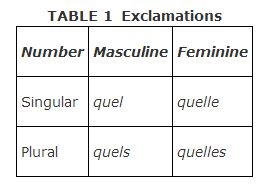Unlike in English, most adjectives in French follow the nouns they modify:
- une fille heureuse (a happy girl)
- un ciel bleu (a blue sky)
A few short, descriptive adjectives, usually expressing beauty, age, goodness, and size (you can remember this with the acronym BAGS), generally precede the nouns they modify:
- Beauty: beau (beautiful, handsome), joli (pretty)
- Age: nouveau (new), vieux (old), jeune (young)
- Goodness (or lack of it): bon (good), gentil (nice), mauvais (bad)
- Size: grand (large, big), petit (small, little), court (short), long (long), gros (fat , thick), large (wide)
Other common adjectives that precede the noun (but do not fall into the BAGS categories) include the following:
In addition, tout precedes both the noun and the definite article ( le, la, l', les):
- tous les hommes (all the men)
- toutes les femmes(all the women)
To use more than one adjective in a description, place each adjective according to its normal position before or after the noun. Two adjectives in the same position are joined by et (and):
- une longue et mauvaise histoire (a long, bad story)
- une grande maison blanche (a big, white house)
Past participles may be used as adjectives and, therefore, must agree with the nouns they modify:
- C'était une surprise inattendue. (It was an unexpected surprise.)
- Ces places sont prises. (These seats are taken.)
The meaning of some adjectives changes depending on the placement of the adjective before or after the noun it modifies. Before a noun, the adjective has a figurative sense; after a noun, the adjective is used literally:

Irregular adjectives
Be careful to use the following irregular adjectives correctly:
- meilleur( e)( s) (better)
- le ( la/les) meilleur ( e)( s) (the best)
and
- le ( la/les) plus mauvais( e)( s) (the worst)
Use the adjective quel when exclaiming:
- Quelle belle maison!(What a beautiful house!)
- Quelles histoires intéressantes! (What interesting stories!)
Quel must agree with the noun it modifies, as shown in Table 1.
